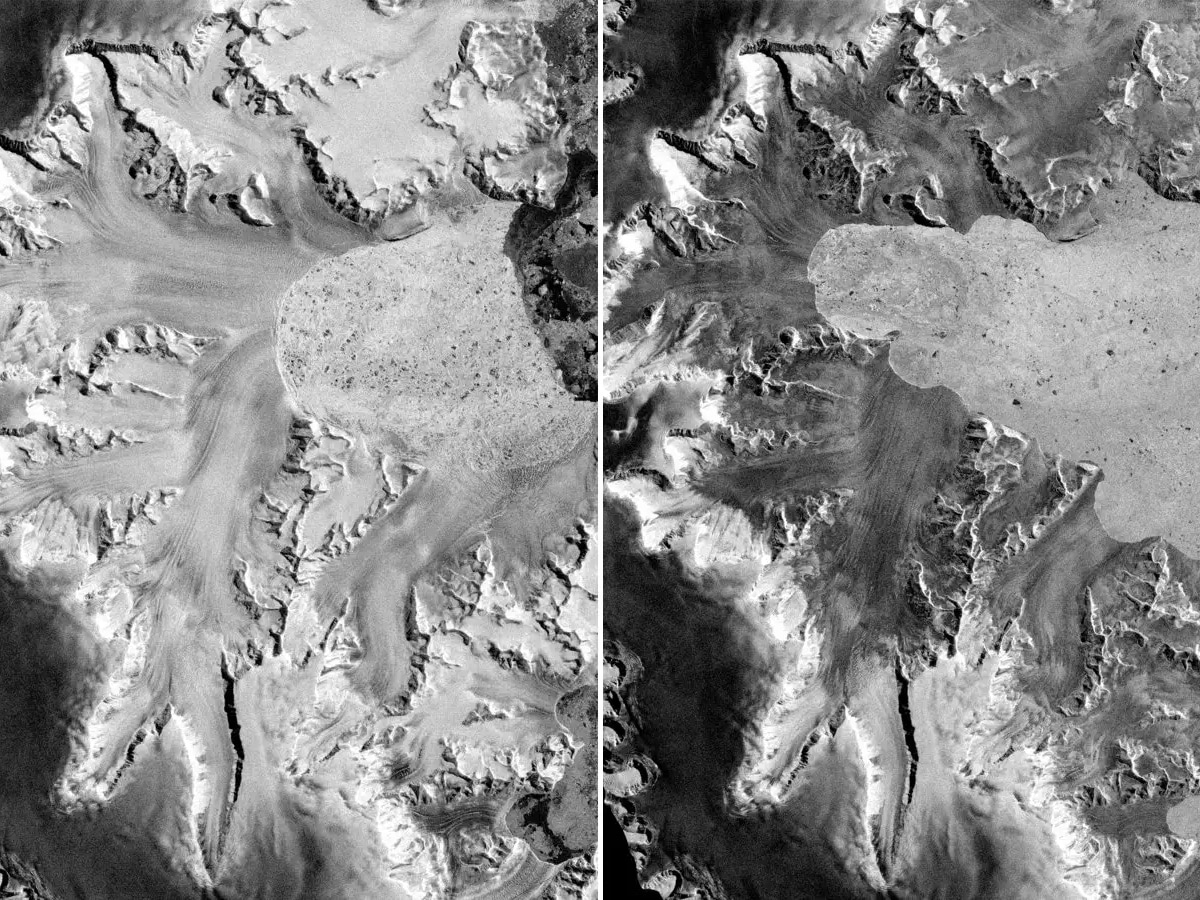The scientific journal Nature Geoscience published an alarming report by a team of Antarctic researchers, who observed a record-breaking glacial retreat between January 2022 and March 2023. Located on the eastern Antarctic Peninsula, the roughly 300-square-kilometre Hektoria Glacier retreated by 25 kilometres during this period. Of particular note was an accelerated retreat of 8.2 ± 0.2 km between November and December 2022, representing a “retreat rate nearly an order of magnitude faster than published values.” Here’s a closer look at the report and its implications.
What’s a Glacial Retreat and What Caused This One?
“Glacial retreat” occurs when the rate of melting and sublimation exceeds the rate of snow accumulation, spurring a net loss of overall mass. When the Larsen B ice shelf collapsed in 2002, glaciers buttressed by the shelf, including Hektoria, retreated at an accelerated rate over the nine years that followed.
In 2011, the Larsen B embayment filled with fast ice – i.e. stationary ice that’s attached to a fixed point (usually a shore or seafloor) – improved stabilisation. When the fast ice broke out in 2022, the glaciers began to retreat once again, this time at an even faster rate.
Initially, it was thought that atmospheric or oceanic conditions caused the glacial retreat, but the latest study concludes otherwise. It’s now believed that the retreat began with a transition from tabular iceberg calving to buoyancy-driven calving on an ice plain, a rare process where the glacier’s front thins enough to float off the flat seabed, allowing ocean water to rush underneath and break it apart rapidly from below.
With the newfound conclusion comes the increased possibility “that marine-terminating glaciers with ice plain bed geometry can be easily destabilised.”

What Now?
Hektoria is relatively small for an Antarctic glacier, so its accelerated retreat won’t necessarily render a notable impact on the environment. However, researchers at the University of Colorado Boulder are raising alarm bells over the potential for additional retreats. Should larger glaciers follow the same pattern, it “would have catastrophic implications for global sea level rise,” according to a press release from the university’s Cooperative Institute for Research in Environmental Sciences (CIRES).
Is There a Climate Change Connection?
The Hektoria Glacier retreat was attributed to an ice calving process, but scientists are pointing to climate change as an underlying factor. In the Nature Geoscience report, researchers warn, “As the climate continues to warm, ice shelves and multi-year fast ice are increasingly susceptible to collapse, thus exposing the glaciers to new stress regimes and external forcings.”
An article by ABC’s Antarctic reporter Jano Gibson similarly addresses the impact of climate change on glacial retreat. Poul Christoffersen, a glaciologist at the Institute for Marine and Antarctic Studies at the University of Tasmania, told the reporter, “The glaciers are showing signs or characteristics of glaciers elsewhere on the Earth that are typically warmer.”
Christoffersen (who was not directly involved in the recent study) claims that the Hektoria Glacier retreat coincides with rapid environmental changes in both Antarctica and Greenland. “Some people call that the ‘Arctic-ification’ or ‘Greenland-ification’ of Antarctica,” he said. He also noted that the study corroborates the hypothesis that glaciers rapidly retreated thousands of years ago.

What is Australia Doing About Climate Change?
In 2022, the Australian government established the Department of Climate Change, Energy, the Environment, and Water (DCCEEW). The department’s current climate policies are primarily based on legally binding targets, with the ultimate goal of achieving net-zero emissions by 2050.
Over subsequent decades, the DCCEEW aims to transition Australia’s energy sector toward renewable energy sources and reduce greenhouse gas emissions, all while maintaining the nation’s economic viability. You can visit their website to learn more about the nation’s pathway to a net-zero economy.
The Hektoria Glacier’s retreat serves as a critical case study of this new, rapid process of destabilisation. Scientists warn that if similar flat-bottomed conditions occur with much larger glaciers, such as those in the Thwaites or Pine Island systems, their collapse could be far faster than current models predict, with catastrophic implications for global sea-level rise.
Climate Change FAQs
The primary cause was a rare “buoyancy-driven calving” process. This was triggered after the protective “fast ice” in the bay broke up in 2022, exposing the glacier. Because the glacier was resting on a very flat seabed (an “ice plain”), it thinned, lifted off the bottom, and allowed warmer ocean water to rush underneath, which then broke the glacier apart with unprecedented speed.
Yes. While the direct mechanical cause was the calving process, scientists state that climate change is the underlying factor that enables this to occur. The Nature Geoscience study and associated commentary note that a warming climate makes the protective ice shelves and fast ice “increasingly susceptible to collapse,” which in turn exposes glaciers like Hektoria to these new, rapid break-up processes.
In 2022, the Australian government established the Department of Climate Change, Energy, the Environment, and Water (DCCEEW) to deliver on the government’s climate agenda. The department’s current policy is based on legally binding targets, with the primary goal of achieving net-zero emissions by 2050 through the transition of Australia’s energy sector to renewable sources.



































Comments
We love hearing from you. or to leave a comment.